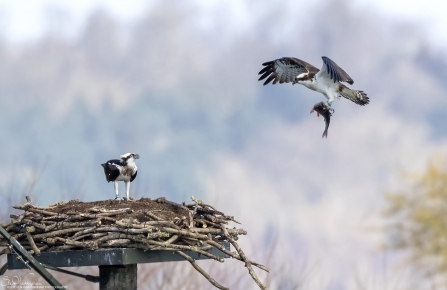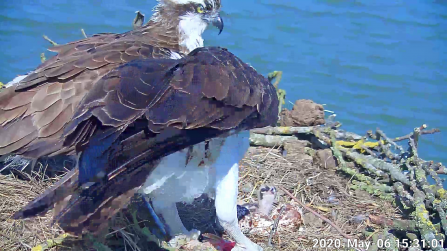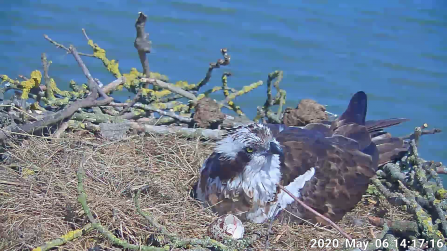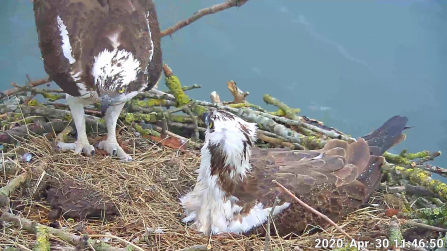You just never know what might happen during each monitoring shift.
Osprey Thoughts
(c) John Wright

Steve Waddingham
We feel fortunate to be part of the Osprey Project Volunteer Team at Rutland Water. You just never know what might happen during each monitoring shift. We’ve had many fascinating highlights which include observing the growing bond between the Manton Bay breeding pair (Maya & 33(11)) from the moment they reunite each year at Manton Bay after their long journeys from lone wintering grounds and, how they share parental nurturing duties from incubation to fledging and the point of migration. Parent birds teaching their young to fish is special to watch as are the aerial battles with intruding birds who get too close to the nest for comfort. Often the Ospreys simply perch in full view for long periods as if watching the world go by….quiet time.
Spotting the other wildlife from the Waderscrape Hide is fantastic too, such as the Barn Owl hunting in the meadow opposite, a Water Rail furtively peeping out of the reed bed in front, a fleeting glimpse of a Kingfisher perched on a bulrush, warblers and buntings showing themselves and flitting from reed to reed, water voles in the channels, muntjacs grazing and the odd fox prowling to name but a few. We look forward to the season every year.
Some visits are more than special, they are the source of treasured memories.

As we all know, every visit to Waderscrape Hide is special. However some visits are more than special, they are the source of treasured memories. I was lucky enough to experience such a morning a couple of years ago.
Monitoring had followed the usual pattern of checking where the adult birds were, which one was sitting on the eggs, had any fish been caught, were there any intruders
Towards the end of the shift Maya became more active in the nest, continually lifting herself off the four eggs and, with head on one side, appeared to be listening to one. The end of our shift was fast approaching but all of our attention was centred on the camera screen!
After Maya had made a good number of circuits of the nest, we realised that the egg she was focusing on had a tiny hole in the shell! An osprey was hatching! Going home time was ignored! We were not going anywhere - such was the magic of the event. Slowly tiny cracks started to radiate from the hole - a pattern of crazy paving developed in the familiar creamy, chestnut blotched shell. With a little incredibly delicate help from Maya some of the tiny pieces of shell were gently lifted away. A slightly larger hole was created. A tiny beak could be seen. Chick number one was hatching! With more gigantic efforts from inside the egg and more general housekeeping by Maya more shell was removed, and a larger hole was created. Eventually more of the new, tiniest osprey was visible.
Such a ritual is replicated every season. The wonder of witnessing new life hatching will remain with me every season.
As we watched, a stunning point of piercing light burst through the orange haze in an instant and shot down the reservoir towards the nest leaving a thin silver reflection on the water

After five weeks of carrying out virtual osprey monitoring at Manton Bay we are settling into a routine just as Maya and 33 are with incubating their four beautiful eggs. Even when the osprey activity is at this slow mundane level there is always something special to observe even though we are only watching two camera images.
Just before starting our early shift, we switched the video on at 05.50am in order to get things set up. The image on the wide-angle camera which looks east along the south arm of the reservoir was quite spectacular with an orange ribbon on the horizon beneath a clear blue sky. As we watched, a stunning point of piercing light burst through the orange haze in an instant and shot down the reservoir towards the nest leaving a thin silver reflection on the water. We had just witnessed sunrise, what a great start to our shift.
Although beautiful, the day was cold with a strong easterly wind forcing Maya to lay very low in the nest. Then at 06.07am 33 landed on the nest and quickly snuggled down beside Maya who had refused to move, no doubt thinking that she was not about to leave behind her four warm eggs. 33 stayed there until 06.23am when no doubt he was warm enough and decided to leave the nest. We have rarely witnessed this sort of endearing osprey behaviour where the birds show apparent affection towards each other. Maya did eventually give up the incubating over the cosy nest cup but not for long as 33 was only allowed three minutes to get warm before she returned.
What a day, not much happened but what we did see was absolutely fascinating.
Enter the water rails to fill that void. Little black pom-poms with spindly legs constantly demanding to be fed.

It’s not the same is it? Trying to monitor the ospreys via the internet; frames freezing; screen going blank! It does bring home, however, the pleasure that working from the Waderscrape hide provides. Not that it was always that way. Do you remember the old hide? The leaking roof, the ill-fitting, often warped, observation flaps. Every time the north wind brought a rain storm we had to retreat to the back of the hide to keep dry, hastily taking the recording papers with us. Trying to guess how many chicks there were, what type of fish had been caught.
And then the technology break-through when we had the webcam relayed to a monitor in the hide. The battery which fed the monitor tended to last until 4pm, so, being 1-5pm shifters, Helen and I had to go blind for the final hour. But we enjoyed great moments, such as the occasion when 5R came flying in from a northerly direction, hotly pursued by a red kite. 5R was carrying something black which he dropped into the nest. At this point the kite gave up the chase and flew off. This was just the beginning of the saga, however. The female (was it Maya?) took issue with the new gift and moved to the edge of the nest. After contacting the Lyndon centre – this was pre new technology – we were able to ascertain that the gift was a crow’s wing! Had 5R stolen the kite’s lunch? After much hassle from the female the wing was disposed of in the water.
And the time when we were monitoring at Site B and 03/97 brought in a koi carp! It was unmistakeable – bright orange and quite a size. The problem is that when you know where to find one koi carp you probably know where to find another!
Back in 2008 when 08(97) had left 5N(04) to fend for herself for hours on end, her eggs failed to hatch, so sadly there were no chicks to monitor. Enter the water rails to fill the void. Their sizeable clutch spent many an afternoon running up and down in front of Waderscrape. Little black pom-poms with spindly legs constantly demanding to be fed. That summer they were the main attraction and many a visitor came just to see them. One water rail is great to see, but a dozen was superb viewing.
I for one am looking forward to getting back to Waderscrape, even if we have no visitors. Working from home? It’s not the same is it?
Osprey Home School Activities and Resources
The Osprey Education Team are continuing to create fun and engaging resources for all the family to get involved in from home. For more information follow the link below.

